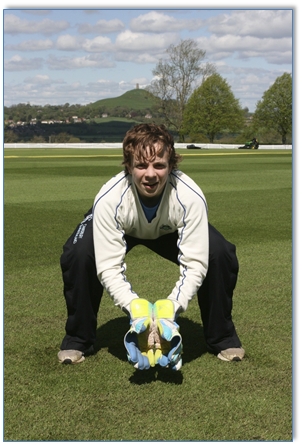Wicket Keeping Secret: Posture is Everything!
 80% of balls that are missed by a keeper go under the hands!
80% of balls that are missed by a keeper go under the hands!
This is a finding from from the study I did in 2008 monitoring 52 high performance keepers from Under 11 County Age Group keepers to MS Dhoni and Mathew Prior in Test Cricket.
The ball goes under the hands as a result of a couple of things:
- Poor posture in stance
- Poor posture at ball bounce
- Leading the upward movement with the head into the attempted take
The solution is to work at your posture and controlling your start position and transition into ball take.
The "Z" position is a term that was developed by Bruce French; ECB Lead Wicket Keeping coach to describe the posture that provides stability, control, power and appropriate head and hand height to a wicket keeper preparing to move into a position to take a ball.
If you control this position then you give yourself the best chance of meeting the upcoming challenges that the ball or conditions throw at you.



The keeper creates a Z shape: starting at his feet working all the way up the lower leg, changing direction along the Femur with the top of the Z shape starting at the hips and finishing at the top of the head. The back is flat and chin is away from the chest. This posture provides the keeper with:
- Stability: A strong base that provides the foundation for both lateral (side to side) and upward (covering the bouncing ball) movement. The hands are near the ground and are in a position to come up with the bounce of the ball.
- Power: The legs are in a strong position with the Quadriceps and Gluteals loaded with energy ready to power into a position to take the ball. Ensure that the feet are pointing down the wicket as this then allows the joints (Ankles, Knees, Hips) to work in the way that they are designed as you come up with the bounce of the ball.
- Balance: weight is evenly distributed across the balls of both feet. This means that sideways movement (to the offside and legside) can be achieved easily.
- Vision: Chin is up, eyes are level and in position to take in as much visual information as possible to inform you of the appropriate movement pattern to take to take the ball cleanly.
This position is a great starting point and means that the last thing to rise is the head and the hands. The hands should remain low (fingers touching the ground) until ball bounce, then the body unwinds with the bounce of the ball and the hands therefore also hands can rise with the bounce of the ball.
As a result, the ball and hands remain on the same height and line and the ball is more likely to nestle into the gloves rather than disappear past you or clatter into the bottom of your fingers creating those nasty bruises and fractures.
The basis of all wicket keeping (standing up and standing back) originates from this starting position. Master this and you’re on the path to wicket keeping excellence.
The brilliant thing about this position is that it’s not just Keepers who can benefit from good posture, all fielders can. I am currently coaching at Millfield School here in the UK. The 1st XI has taken 10 Slip catches already this season compared to zero in 2010. This is purely down to the posture work that the players put in during the off season.
Now I'm no mathematician, but those seem like positive numbers to me!
- Login to post comments


Comments
Hi Mark,
good points made. The wicket keepers have to practice those posiitons in training and to work on a static jump action from the squat. Compared that to a counter movement which is too slow.
I do the same with the goalkeepers I work with.